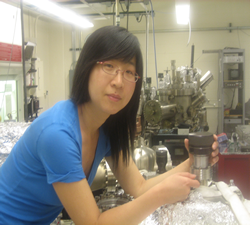- Speaker
- Prof. Ying Liu
- Institute for Quantum Computing, University of Waterloo, CA
- Abstract
Sparked by the isolation of graphene in 2004, recent research has uncovered a new class of materials with their low-energy fermionic excitations behaving as massless Dirac particles rather than fermions obeying the canonical Schrödinger equation. In this talk, I will first briefly try to give a sense of why Dirac materials have generated such excitement in condensed matter physics. I will then discuss our work on the atomic resolution imaging of vacancy defects in graphene using non-contact atomic force microscopy, and the direct determination of charge states by local contact potential difference measurement[1]. Lastly, I will show the tunability of the Dirac fermions in three-dimensional topological insulator Bi2Se3 by strain and electrical field near grain boundaries[2-4], as probed by scanning tunneling spectroscopy. This demonstration of tunability highlights the feasibility of nanoscale quantum devices based on Dirac materials.
[1] “Determining charge state of graphene vacancy by noncontact atomic force microscopy and first-principles calculations”, Y. Liu, M. Weinert, and L. Li, Nanotechnology 26, 035702 (2015).
[2] “Spiral growth without dislocations: Molecular beam epitaxy of the topological insulator Bi2Se3 on epitaxial graphene/SiC(0001)”, Y. Liu, M. Weinert, and L. Li, Phys. Rev. Lett 108, 115501 (2012).
[3] “Charging Dirac states at antiphase domain boundaries in the three-dimensional topological insulator Bi2Se3”, Y. Liu, Y. Y. Li, D. Gilks, V. K. Lazarov, M. Weinert, and L. Li. Phys. Rev. Lett. 110, 186804 (2013).
[4] “Tuning Dirac states by strain in the topological insulator Bi2Se3”, Y. Liu, Y. Y. Li, S. Rajput, D. Gilks, L. Lari, P. L. Galindo, M. Weinert, V. K. Lazarov, and L. Li, Nature Phys., 10,294 (2014).
- About the Speaker
Dr. Ying Liu earned her PhD from Physics Department in Hong Kong University, and worked in a few groups in Europe, US and Canada after PhD graduate. Her expertise is on thin film molecular beam epitaxy (MBE) and scanning tunneling microscopy (STM). Her earlier studies focus on conventional semiconductors III-Nitrides heterostructures and diluted magnetic semiconductors. Since 2010 as a postdoc in the University of Wisconsin-Milwaukee, she has been working on epitaxial growth of graphne/SiC and topological insulators. She studied graphene point defects and topological insulator line defects at atomic scale using scanning probe microscopy. In 2013 she started to work on the micro-fabrications of topological insulator-based nanodevices as a Research Associate in the Institute for Quantum Computing in University of Waterloo, Canada. Her future research interests are exploring advanced materials for novel quantum device applications, especially interest on the state-of-the-art materials with promising applications in quantum computing.
- Date&Time
- 2015-08-20 3:00 PM
- Location
- Room: A403 Meeting Room




